Padua, Veneto, Italy, Monday, September 10, 2012
Breakfast is not included here so we sleep in today. We still arrive at The Basilica of St. Anthony at 0915, early enough to avoid the tour bus crowds. The Basilica was recognized as an international shrine by Pope John Paul II in 1993. The church was started in 1231, immediately after the death of St. Anthony. He was born to a rich, well educated family in Lisbon. At age 25 he was inspired to join the Franciscans and moved to Italy. He lived in a cave, studying and meditating. Then at a service with fellow monks, the speaker did not show and he stepped in. He did so well that St Francis heard about it and asked him to travel and speak. He is known as a great speaker, miracle worker, and the finder of lost things. He died at the young age of 36 succumbing to an illness.
The Basilica is a pilgrimage site and we saw many priests, nuns, and ordinary people praying and visiting his tomb. There are cards and letters stuck to the side from people who have prayers and giving thanks for prayers received. The tomb is surrounded by nine marble reliefs depicting miracles from the life of the saint. In one a jealous husband stabbed his wife and St. Anthony asked God to bring her back to life. Another has a drowned boy who is blessed and revived by the Saint. A third one depicts a young man who cut off his own foot because he disrespected his mother by kicking her. She asks the Saint to help and his prayers to God enable him to reattach the foot. There are six other reliefs. People walk behind the tomb and touch it while they say their prayers to the saint. Almost 800 years later, St Anthony still evokes people’s spiritual nature.
To the right of the tomb is the original chapel where St. Anthony was buried in 1231. We go behind the alter to the chapel of the reliquaries. This holds relics of the Saint with the most prized being his tongue and vocal chords. 32 years after his death, his body was exhumed, it had all turned to dust except for his tongue which was miraculously intact and reddish in color. The display case also holds his lower jaw still well preserved, and vocal chords which also are intact and were only discovered when his body was examined in 1981. It does seem pretty amazing as he was known as a preacher who could not stop talking about God and the mouth, tongue, and vocal chords are well preserved.
We exit the Basilica and visit the small museum of St. Anthony. It is very nice and has items sent to the saint for per grazia ricevuta, for answered prayers, and they range from century old small paintings, to medals, personal items, pictures, and letters from all around the world.
We still have a few hours before our 1400 appointment at the Scrovegni chapel so we decide to walk around Padua and then go to see the Duomo Baptistry. I wanted to visit the observatory sitting atop an old building since the late 1800s but it is only open on weekends. It is still a picturesque little area as we walk along some canals. We wind our way to the very plain Duomo and go into the Baptistry next door. It was the private chapel of Paduas ruling family until 1405 when Venice moved in, killed the family, and made it a Baptistry. The ceiling Fresco dates from 1370 and shows Christ in the middle surrounded by a multitude of saints.
We are hungry and wander down a small side alley to look for a restaurant we had read about and come upon a little pizzeria. The pizza looks good, is priced very cheap, and it smells good. We order one vegetarian slice, one farinata made from chick peas, and a panzerotti for under 4 Euros. It looks new and we ask the owner who tells us he just opened 5 days ago. Eating in the nearby square,it is very good. The chick pea item is good but not something we would order again but you have to try the local flavors.
We walk over to the chapel, get our tickets, and wait for our time to get in. Enrico Scrovegni had the chapel built and hired the brilliant painter, Giotto, to fresco it. Scrovegni had it built out of guilt for his father( and probably himself), a usurer, which is to say he was a precursor to today’s loan sharks charging extremely high interest rates at a time when the church forbade doing so. His father Reginaldo had a reputation that even got Dante’s attention, and Dante placed Reginaldo in one of the levels of hell in his Inferno. Reginaldo was denied a Christian burial by the church so Enrico figured he could buy forgiveness by building this chapel.
The real story though is Giotto, who was groundbreaking in the use of expression, 3D look, lively color variation, and humanism. Many Renaissance painters got their inspiration from Giotto. The chapel is completely covered in frescoes which Giotto painted over two hundred days in a two year period (1303-1305). There is a cycle of almost 40 frescoes starting with Joaquim and his wife ( parents of Mary), Mary’s birth and life, and progressing to Jesus’s birth, life, and death. One wall is then dedicated to the last judgement where lives are eternally sent to heaven or hell. Hell depicts Satan as an ogre munching on sinners while demons torture those who have not lived well. Scrovegni himself is portrayed in the painting in a penitent violet robe protected under the cross and donating the chapel to the church in forgiveness for his fathers sins. Scrovegni himself is buried at the other end of the chapel.
The history of restoring this chapel is very interesting as the Frescos had been damaged over the years. It is controlled like the Last Supper with only 25 people allowed in at once, and a dehumidifying process. No pictures inside but if you are interested look it up and the art of frescoing which is very interesting in itself. We take the tram back to our hotel so we can relax a little before dinner.
We decide dinner should be pizza and wine in the room so we head back to where we had lunch, where the owner is surprised to see us again. He has moved here from Torino to start his business as he has friends here and likes the town. Pizza and wine in hand we go back for a nice quiet meal in our room. An hour later, we go out for gelato, and our day ends.
Padova is a different kind of town then Verona with a University in it. One thing we did not like is that every street had some kind of graffiti on it. It really took away some from the feel of the town. It is a shame but I really think the young people do not appreciate what they have in history and culture, or do not respect that the look of the city is enhanced by its older buildings and architecture. Other than that, we enjoyed the sights we saw here.
CNC
“Happy is the man whose words issue from the Spirit and not from himself”- St. Anthony
Expenses
4.40E- Pizza Snack from Gusto
4.10E- Pizza and Panzerotti from Lo Sbrano on Via Gritti 7
3.88E- Wine and toothpaste
8.40E- Pizza dinner
4E- gelato
71.10E-Hotel al Fagiano
Miles Walked – 5 Miles
- Jealous Husband
- Marble Panel by St. Anthony Tomb
- St. Anthony’s Tomb
- Sent Over the Years
- St. Anthony Pray For Us
- Padova Porticos
- CNC Padova Observatory
- Quiet Padova Nook
- Frescoes Circa 1370

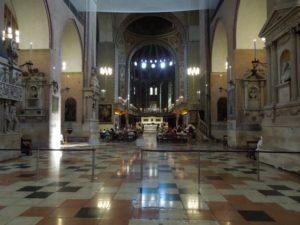


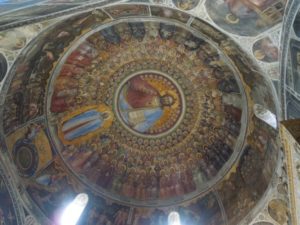
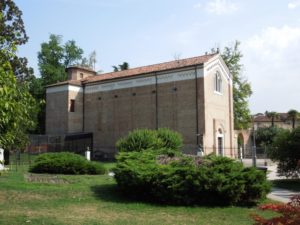
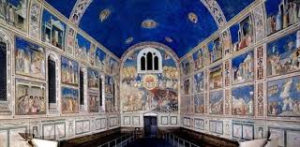

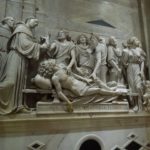
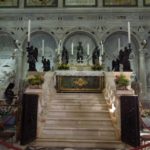
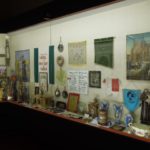
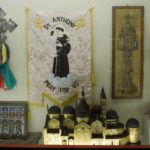
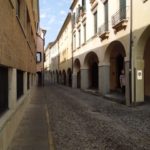
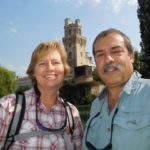
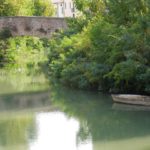
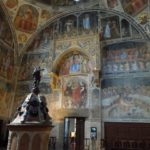
Yum wine and toothpaste:)
From Darci, on Sep 19, 2012 at 04:41AM